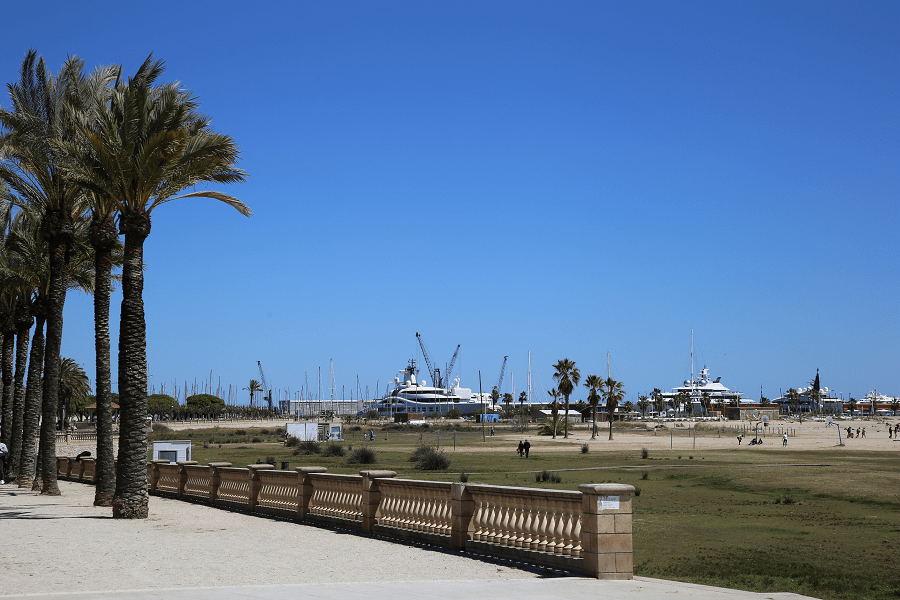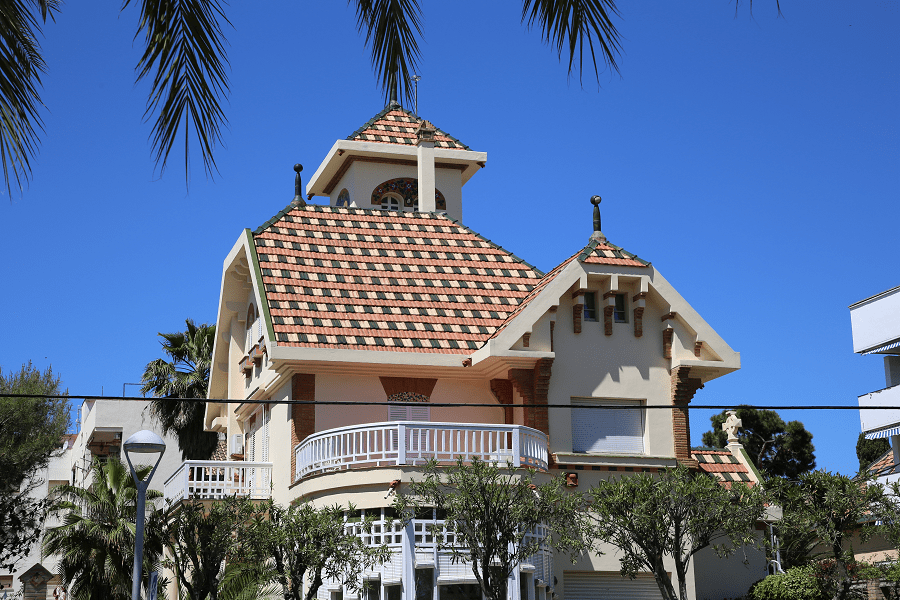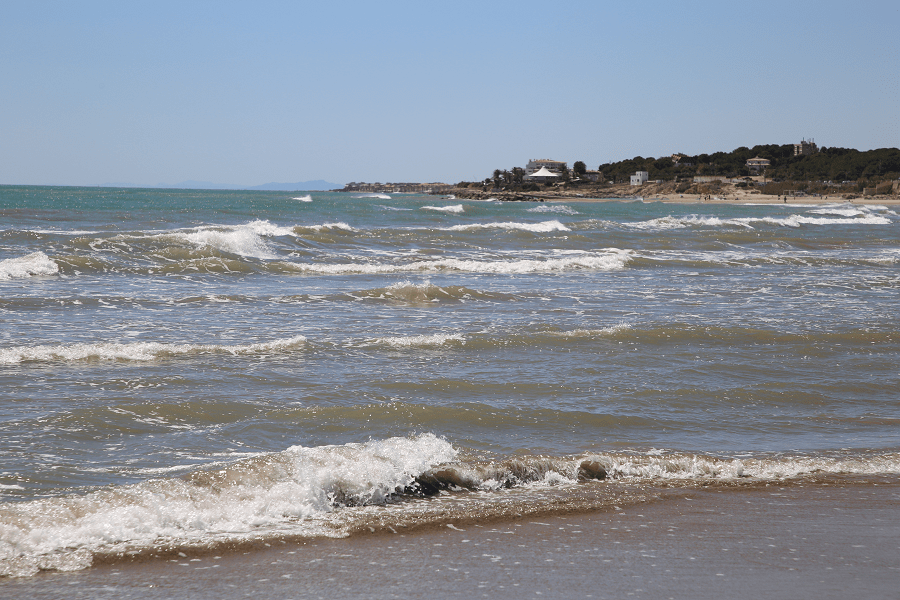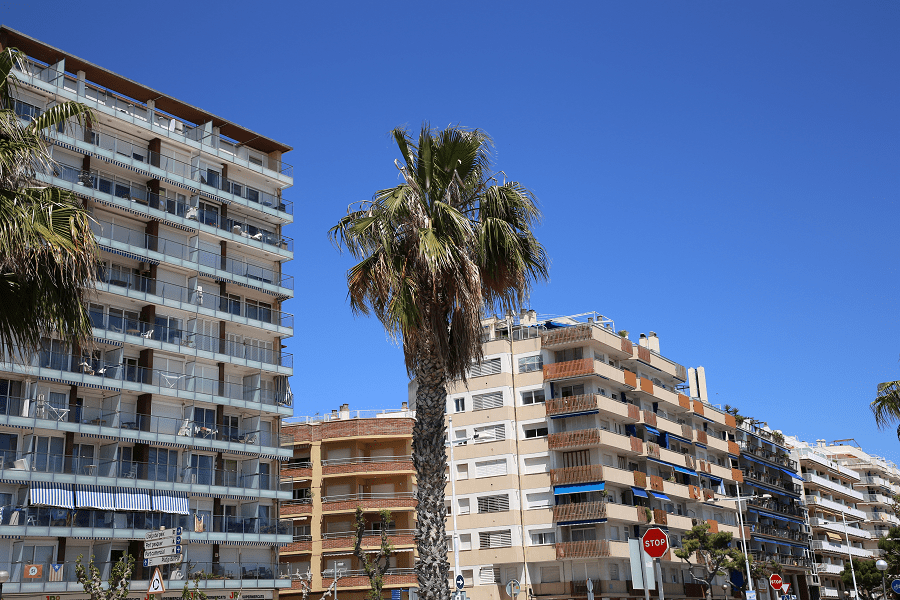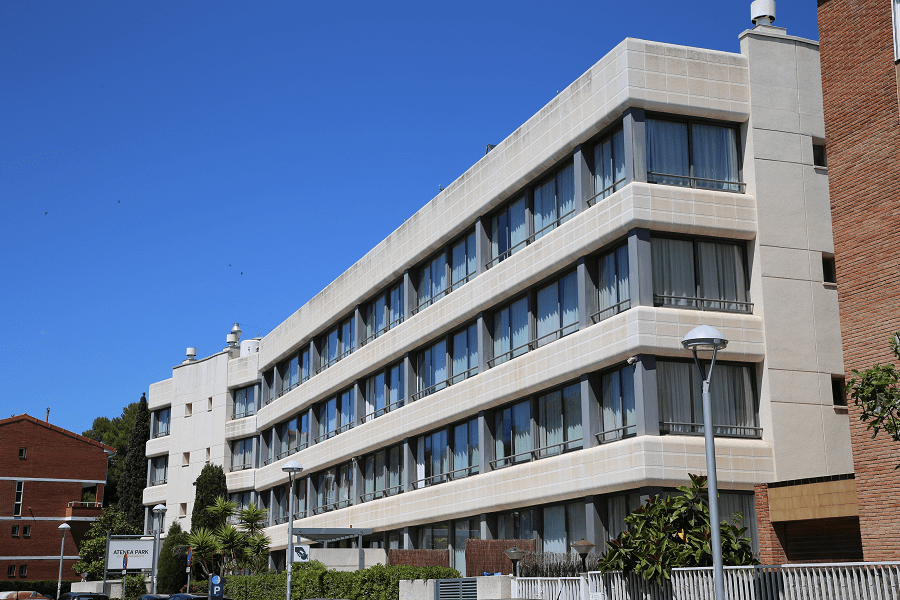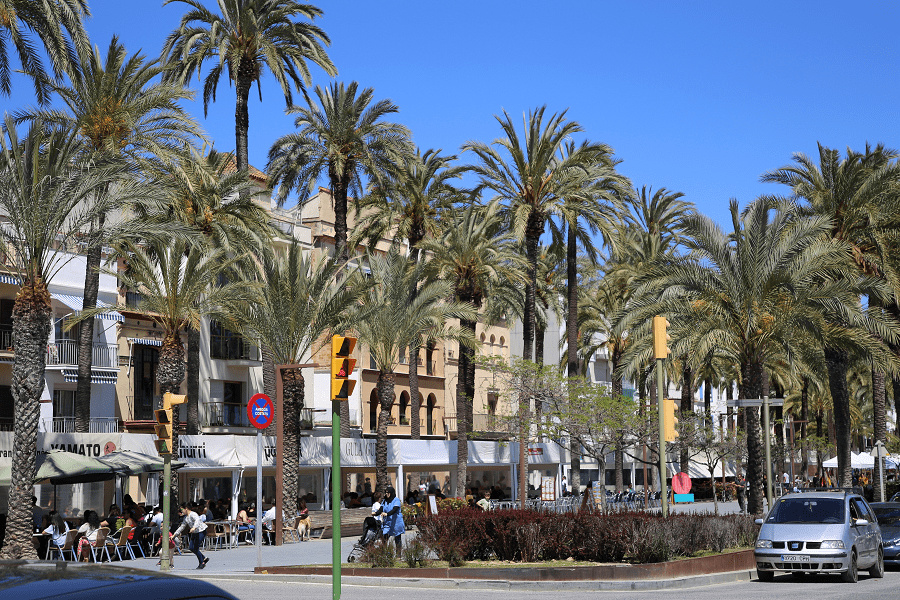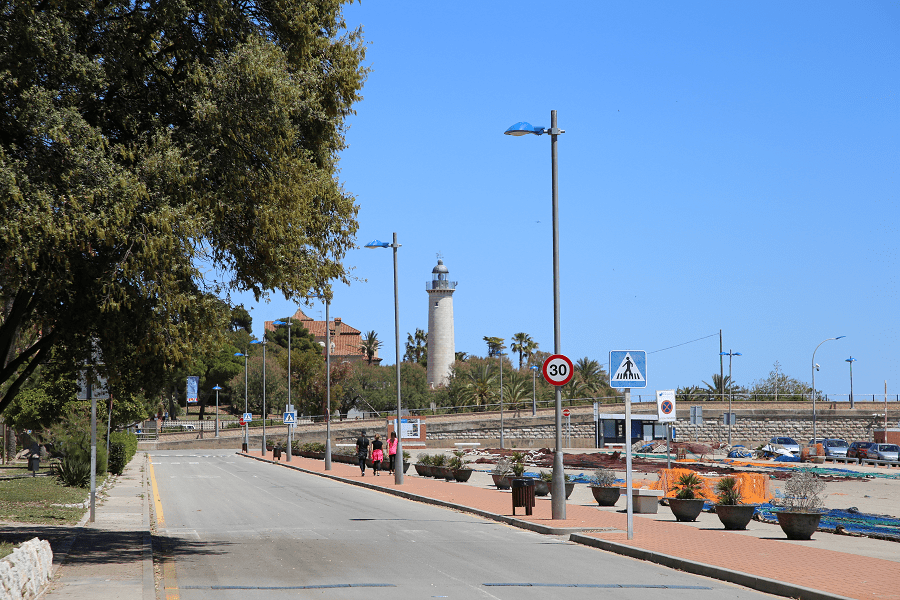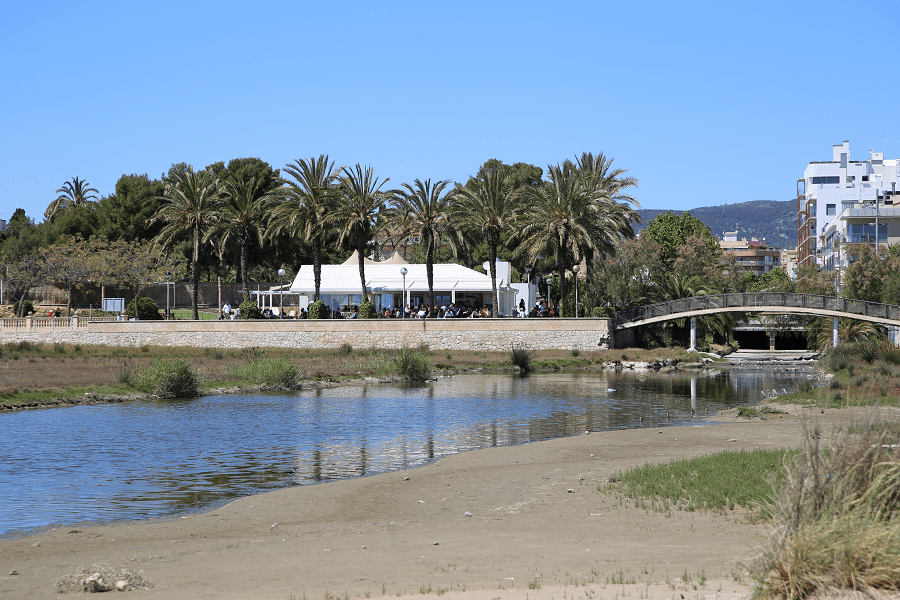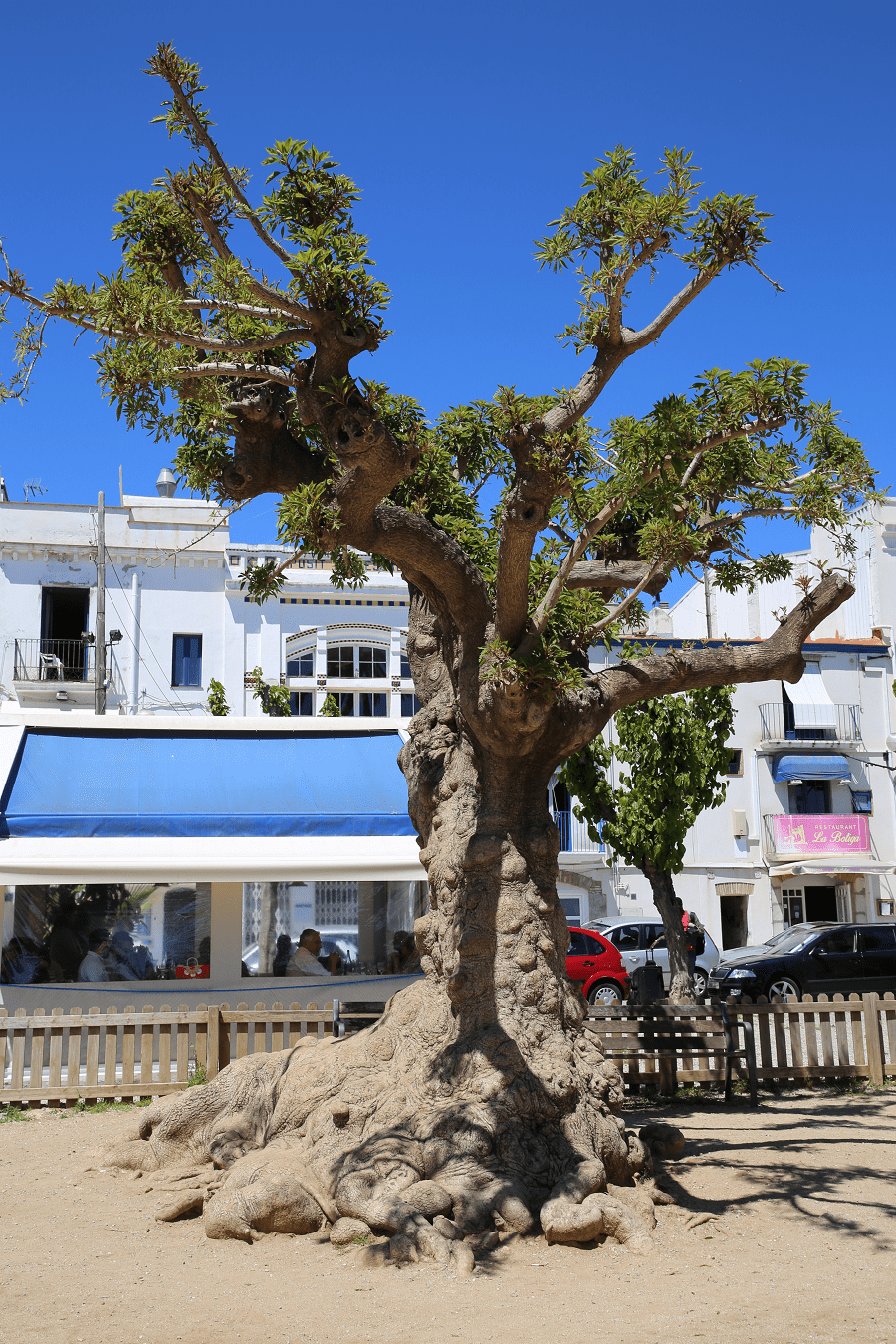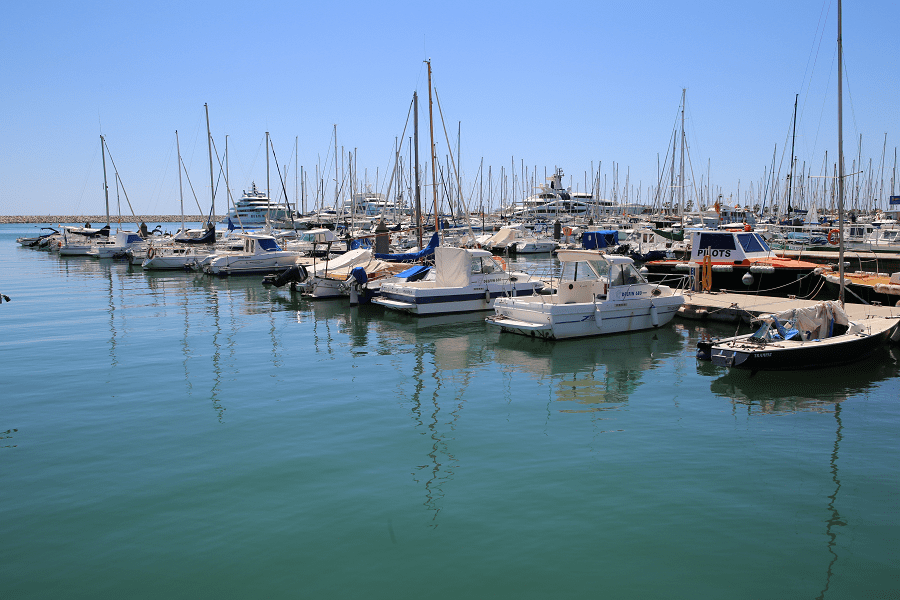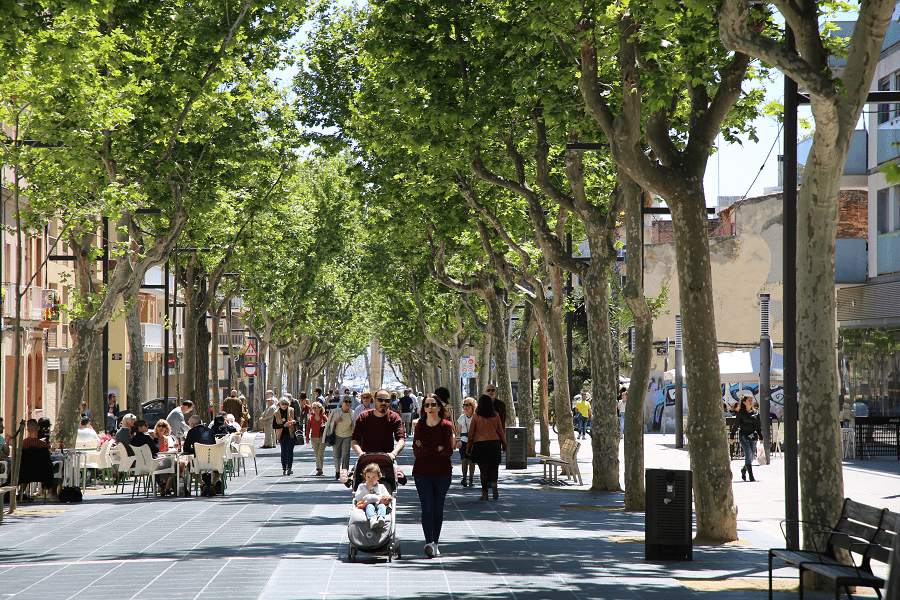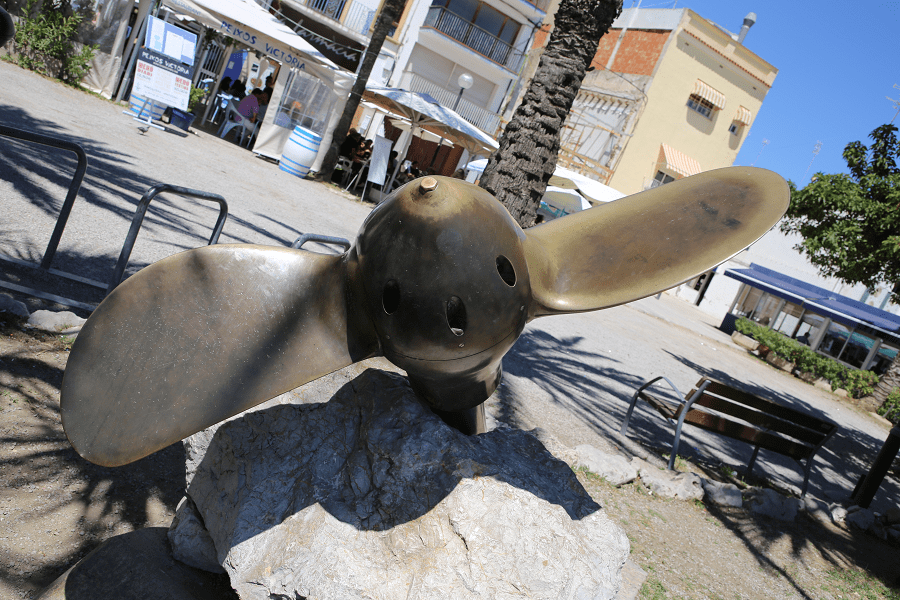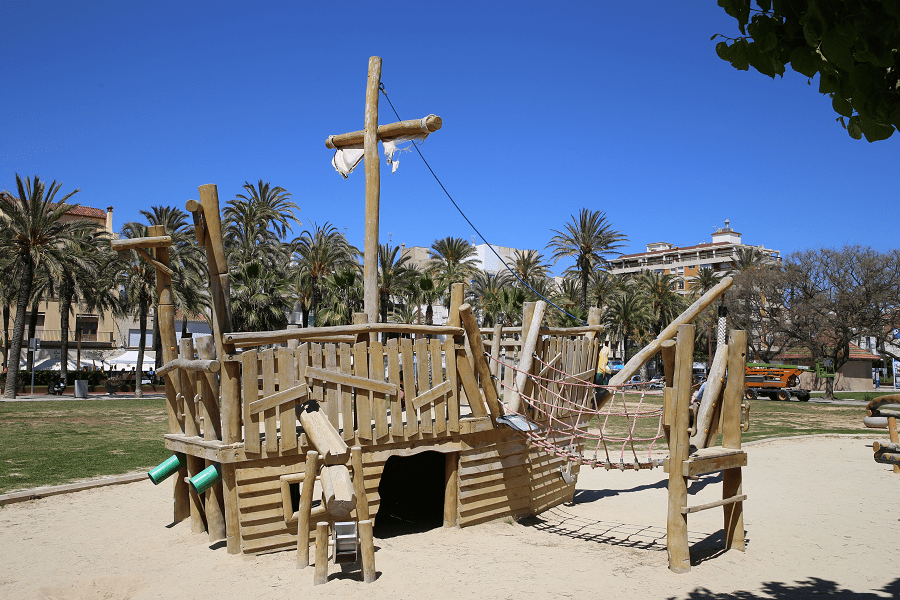Vilanova i la Geltrú (cat. Vilanova i la Geltrú) is a city and municipality in Spain, it is also the capital of the Garraf region, Catalonia. Historically, it is the result of the aggregation of the town of Geltrú, formerly an independent municipality within Vilanova de Cubelles, which used to belong to the municipality of Cubelles, a municipality that currently borders Vilanova and Geltrú. Even so, nowadays it is impossible to distinguish the two population centers, due to the great demographic growth, that has led them to form a complete urban conurbation. It borders with Cubelles, Castellet and Gornal, Canyelles and Sant Pere de Ribes.
It’s a popular part of the Costa del Garraf of the Mediterranean resorts of Spain.
History
According to the legend, Vilanova de Cubelles was founded as a response to the bad treatments that the feudal lord made, from his residence in La Geltrú (droit du seigneur or lord’s right). This caused many citizens of Geltrú to leave the sea, for the territory of Cubelles, where they founded Vilanova near Cubelles, or de Cubelles. Years later, King James I granted it the town charter (1274).
In the mid-18th century, when King Charles III allowed Vilanova de Cubelles to open trade with the Americas, the city experienced a very important economic boom, a progress that was not limited to an accumulation of wealth, but also led to an investment in culture.
It is then that in Vilanova de Cubelles the first recreational societies, meeting places and leisure areas were founded. In this way, at the beginning of the 19th century, appeared, among others, the gardens of Tivoli. In this sense, Vilanova was called Havana Xica, both due to the lushness of the meeting gardens and the atmosphere that the contact with the island of Cuba was giving it.
In 1804, Pere Gumà erected the first theater of Vilanova: La Sala, it was a space, with a square floor plan covered with vaults, that served as both: theater and dance hall.
During the 19th century, the city was transformed into an industrial one, a process initiated with the installation of a factory on La Rambla in 1839 and subsequently affected by the arrival of the railway to the town, which eventually led to the creation of Cultural infrastructures such as the Víctor Balaguer Museum Library.
Tourism, architecture, sights and main places of interest
The Plaça de la Vila is a square that is a monument of the municipality of Vilanova i la Geltrú (Garraf) protected as a cultural asset of local interest. The Plaça de la Vila is located in the centre of the city. It has a rectangular and has porches on the two larger streets. It is crossed by two smaller side streets. The north and south facades, which are the larger ones, have a symmetrical composition. The porches, with horseshoe arches, occupy the ground and main floor. On the upper two floors, the balconies are aligned vertically and horizontally and have rectangular windows. The crowning is formed by a cornice and a railing balustrade separated by elements of masonry. The east facade has a ground floor and three upper floors, it follows the same structure as the other ones. The west facade, divided by a street, is flanked by the Manuel Olivella house and by a building that replaced the Public Schools.
The current Plaza de la Vila occupies a space where the Capuchin Friars Convent stood before. The convent was put up for sale in 1835, during the dislocation period. In 1845 it was bought by Josep Parellada. Subsequently, the building became the property of Josep Tomàs Ventosa Soler, who proceeded to demolish the construction to build public schools. In 1851 permission was given for the construction of the school and the convent was demolished. That same year, Mr Ventosa gave part of the land to the municipality and began to configure the current square. In 1864 the schools were inaugurated, in 1867 the Town Hall and in 1874 the adjacent building. In 1878 a new building was opened on the other side of the square, following the project of Josep Salvany.
The monument dedicated to Josep Tomàs Ventosa Soler was placed in 1883 and two years later, the municipal architect, Bonaventura Pollés and Vivó, made a plan to urbanize the square. Recently, the parterres of the monument have been replaced by a staggered structure.
The Torre Blava, or Torre de Ribes Roges, is an ancient Carlist fort located on the beach of Ribes Roges, in the municipality of Vilanova i la Geltrú. Constructed during the third Carlist War, it was rebuilt in the last third of the 19th century and is currently an artistic space dedicated to the Mediterranean and the sailors. It is called the Blue Tower or Guinovart space, after the man who initiated the project. It is considered a Cultural Asset of National Interest since 1949.
The Víctor Balaguer Museum Library, located in the municipality of Vilanova i la Geltrú, was founded in 1884 by Víctor Balaguer. Balaguer wanted to create a universal temple of knowledge open to all to promote education and culture. It is one of the oldest and pioneering cultural facilities in Catalonia since it was the first public building in the country to carry out library and museum functions. Since 2000, the museum is a section of the National Art Museum of Catalonia and the library section of the Biblioteca de Catalunya.
Vilanova i la Geltrú Town Hall is a monument of the municipality of Vilanova i la Geltrú (Garraf) protected as a cultural asset of local interest.
The Town Hall building forms a completely integrated part of the square to which it gives its name. The complex of this square is similar to that of the other 18th century squares, with porches that were constructed after confiscation following the scheme of Josep Boixareu on the porches of Xifré in Barcelona, in which the central body of the building is more forward in relation to that of the other buildings. This central construction body is occupied by the Town Hall, positioned further out on the square making it stand out with respect to the other buildings of residential use that stand beside it.
The porches, with horseshoe arches, the use of terracotta and the details of the architectural language, identify the square and the Town Hall as the most representative romantic neoclassical construction in the city.
Foment Vilanoví is an entity of Vilanova i la Geltrú that was created in 1853 thanks to the impulse of Joan Samà Martí, the brother of the famous indià (indià in Catalan refers to the Catalan emigrants to the Spanish colonies in the Americas) Salvador Samà Mart, and a whole series of people linked to the society and local culture. The objective of the founders was to build an entity that gave rise to different sensibilities and with a clear interest in the local and national culture. The headquarters of the entity, the work of the architect Josep Oriol Bernadet, was located on the Cols Plaça from the very beginning.
Now, more than 150 years later, the Foment maintains the initial spirit and remains a crossroads of the different sociocultural tastes of Vilanova i la Geltrú, of the 21st century. The Foment Vilanoví is, since its founding, a reference point for the Vilanova and Catalan society where some of the artists and intellectuals of the moment showcase.
The Church of the Immaculate Conception is a monument of the municipality of Vilanova i la Geltrú (Garraf) protected as a cultural asset of local interest. It is a church with a single nave, with connected side chapels and a semicircular apse. It is covered with a barrel vault with lunettes in the central nave, with groin vault in the lateral ones and with semicouple in the apse.
The facade is symmetrical, divided into two horizontal bodies by an impost. In the lower part, there is the portal, centered, semicircular and with smooth columns crowned by capitals. In the upper part opens a centered niche, with an image of the Virgin Mary and a clock. The four small openings that are distributed on the facade have semicircular arches. The centered bell tower has a square base which turns into octagonal and lobed openings. It is covered by a pointed dome. Inside there are paintings by artists from Vilanova, Martí Torrents and Alexandre de Cabanyes.
La Masia de Can Xicarró is a monument of the municipality of Vilanova i la Geltrú (Garraf) protected as a cultural asset of local interest. It is an isolated building surrounded by a large garden. It has a square floor plan, with ground floor, first floor, an attic and a perimeter body with a ground floor and a roof that forms a porch on the front. The roof is hipped and the roof of the attic is higher and gabled. The facades have symmetrical composition and have windows with horseshoe arches. A balustrade railing crosses the roof of the porch and the lateral galleries of the cornices under which the name of “Villa Rosa” is inscribed. The attic is made up of a single centered body covered on two sides and with a geminated window. The facade is plastered and decorated with horizontal stripes simulating brick and exposed brick pilasters. Arab inspired elements predominate in the building as a whole.
Torre d’en Garrell is a tower cataloged as a monument in the municipality of Vilanova i la Geltrú (Garraf) and protected as a cultural asset of local interest. It is a circular tower that rises forming a truncated construction with a flat roof. The exterior features irregular stone ashlars and a brick cornice that runs along the top. It has embrasures framed with brick and a separate door.
The interior has a unique space with a centered brick pillar, which supports the roof. There are currently some buildings attached to the tower.
Nin Portal, or Negrell Portal, is a monument of the municipality of Vilanova i la Geltrú (Garraf) protected as a cultural asset of local interest. The portal is approximately 1 meter thick, with a semicircular arch on the side of the square and a segmental arch on the side of the street. Both arches are made of stone. The semicircular one is formed by 15 voussoirs held up by jambs and the segmental one is made with large blocks. Over the arch there is a building that forms part of the Nin house. To the right, on the outside of the portal, there is a fragment of an old wall of an irregular construction.
The Rambla Principalis a street in the municipality of Vilanova i la Geltrú (Garraf) protected as a cultural asset of local interest. It stretches from the Neus Square to the Passeig Marítim. A railway line cuts it perpendicularly in the lower section.
The stretch that goes from Neus Square to Gumà Square is called Rambla Principal, and the section from Gumà Square to the Passeig Marítim is called Rambla de la Pau.
In the centre it has a walkway with trees and on each side a road for vehicles and a sidewalk.
The buildings are generally three storey, with a ground floor and two upper floors. In terms of style they are given various names: eclecticism, modernism, historicism, etc. There are buildings of recent construction that break the unity of the whole.
On the lower section, on the Rambla de la Pau, a lower path has been built for the exclusive use of pedestrians.
The Can Papiol Romantic Museum, or simply Can Papiol, is a museum in the historic center of Vilanova i la Geltrú (Garraf). It is located in a stately home of late 18th century and it preserves both the furniture and the decorative elements of the time. The mission of the museum is to evoke a nineteenth-century society by analyzing the daily life of a wealthy family.
Sea port. Its marina is considered to be in the top 10 most beautiful ports in Europe, mainly due to its specialisation in super yachts.
Museums and library
A representative museum of the city is the Víctor Balaguer Museum Library, legacy of the man who gives it its name. Another museum in the city is Can Papiol located in a well-preserved building of neoclassical style. There is also the Museu de Ferrocarril de Catalunya (Railway museum) and Center for the Interpretation of Romanticism, in Masia d’en Cabanyes. At the Ribes Roges Park there is a miniature railway circuit (127mm wide track) where steam, gasoline and electric trains run on holidays, with passages suitable for the whole family. In order to celebrate the marine heritage of the city, since July 2016, it has the Espai Far dedicated to it. This museum is located in the center of the Far of San Cristóbal, it includes the Museum of the See of Vilanova i la Geltrú, the Víctor Rojas lifeboat and the Roig Toquès Marine curiosity museum.
The Armand Cardona Torrandell Library is a public library of the municipality of Vilanova i la Geltrú (Garraf), which forms part of the Municipal Library Network of the Deputation of Barcelona. It was inaugurated on April 11, 2003. It is a public municipal service open to the entire population, which offers a service of proximity to the inhabitants of the western part of the city. Its main function is to provide access to information, local and global, support for training and promotion of reading and culture.
Culture, festivals and traditions
On January 17th, for Saint Antoni (co-patron saint of the town), the Winter Festival or the Tres Tombs is celebrated. On this day carriages and carts pulled by horses, donkeys and mules make three rounds on the main boulevard of the city to be blessed.
For Carnival, the Carnival of Vilanova i la Geltrú is celebrated, declared a Traditional Festival of National Interest.
On August 5, the Neighborhood Festival of Vilanova i la Geltrú is celebrated. There are several parades that involve a number of popular entremesos (type of traditional performances) and dances: The Dance of Devils, the Dragon of Vilanova, the Dragon of la Geltrú, the Carpa Juanita and Porró, the Mulasses, the Giants, the Dwarves, the dance of Serrallonga, ball de bastons (traditional stick dance), dance de Gitanes, dance de pastorets, dance de cintes, the Moixiganga dance, the castell group Bordegassos de Vilanova, the Falcons group and others.
At Christmas the performances of “Els Pastorets” are performed at the Círcol Catòlic Theater, and also on other occasions at the Teatre Principal.
Vilanova is one of the towns that attribute the origin of the xató, a sauce made, among other ingredients, with hazelnuts, oil, almonds, bread and peppers. The sauce is accompanied by a salad of endive, tuna and cod, and was eaten at the moment when the wine barrels were thrown, that is, when the new wine of the harvest was presented. Currently, the “Route of the Xató” has popularized this dish in the comarques of Penedès.
In addition, various artistic and musical festivals are organized: in May, the Festival of Circ Trapezi, shared with Reus, and in the summer months the Villanova International World Music Festival (or FIMPT), it is celebrated since 1981 and it is the festival of ethnic music (music of the world) with the longest trajectory in Spain, and other annual festivals such as the Nowa Reggae Festival (since 2006), the Ateveu (2007) El Tingladu (2005) or the Vida Festival (2014).
Society
Vilanova i la Geltrú is a city with an active social structure that is strongly linked to the cultural events of the city, to the point where they become key in their organization. Historically, the society of Vilanova has used the associationism as a mechanism of social organization, cultural development, connecting community and political action. It is above all from the 20th century, with the cultural movement of the Catalan Renaissance, that private recreational and cultural societies started to play an important role in the cultural life of the city and proliferated leisure spaces such as the Cercle Artesà, l ‘Orfeó Vilanoví, La Sala, or other private venues. Subsequently, the rivalries between associations and the rich cultural offer in Vilanova benefited the growth and strengthened this associative dynamic.
Throughout history, there have been many associations or important entities in the city, with some of them centenaries existing up to the present day, such as the Vilanoví Foment, the Fisherman’s Guild, the Vilanovina Union or the Círcol Catòlic, and others that have disappeared as is the case of Ràdio Vilanova (1932-1954). After the Spanish democratic transition, the associative structure was rebuilt and grew with the birth of new entities that group hundreds of partners such as A.E. Atalaya, the Popular Dance Group, the Bordegassos de Vilanova, A.S. Vilanovins Dancers, La Gran Penya and several neighbourhood associations. As early as the 21st century, the associative structure was reinforced with new youth organizations such as La Medusa or Can Pistraus. All of them contribute a great human capital to the organization of cultural and festive events in the city on a regular basis.
Examples include the more than 70 entities that make up the Federation of Carnival Associations, one of the festivities organized in the strongest and most direct way by civil society, or the amount of social premises and public events self-managed by various Associations, or the 300 associations registered in the Registry of Entities of the city council at present.
Vilanova i la Geltrú – sea resort and main beaches
There are 8 beaches in total in Vilanova i la Geltrú. The total length – 3.4 km.
The beaches are typical of the Spanish Mediterranean coastline with wide expanses of fine, golden sand and the gentle slope down to the sea that ensures safe paddling and bathing. The majority of the beaches are easily accessible on foot but for the most easterly beach, Platja d’Ibersol public transport is recommended.
Full list of beaches:
The Sant Cristòfol Lighthouse beach is situated in a residential area next to the Sant Cristòfol Lighthouse which guides sailors up and down the Costa de Barcelona and the Costa Daurada. In the same beach area you can find the Sant Cristòfol Hermitage which dates back to the 14th century, acquired by Eugeni d’Ors in 1944 and which was then called the Acadèmia del Far, a meeting place in its day for writers, artists and philosophers.
Fine sand and bordered on the north by rock faces and at the southern end by the Port of Vilanova. Beach of 650 m long and by around 110 m wide.
The Ribes Roges in a residential seafront area is a long, flat beach with fine sand with around 1km in length and 150m wide. The Ribes Roges beach takes its name from the town gardens to be found in the Ribes Roges neighbourhood from the beginning of the 20th century with Modernist and Noucentista styles.
Adarró Beach at its north ends with the Pasiphae, it is situated in the residential seafront of Ribes Roges and is a long, flat beach with fine sand and with 410 m in length and 60 m wide. The Adarró beach takes its name from the Ibero-Romano settlement in this area where you can still see the remains of an Iberian town used by the Cessetani from the 5th to the 1st century BC, and also the remains of a Roman villa in the same site which belonged to the territory of Tarraco.
República Beach is located between Adarró beach and the north end of Sant Gervasi beach. It has a gentle slope and fine sand. It has a length of 140 meters and an average wide of 40 meters. The Republic beach can be found at the foot of Sant Gervasi mount, site of the Baroque style Sant Gervasi hermitage and where there was a fort at the end of the 18th century to defend the coastline. This fort was knocked down and at the beginning of the 20th century the stately Xalet de Miramar was built.
Sant Gervasi Beach is located between Républica and Aiguadolç beaches. It has an urban typology with a gentle slope and fine sand with a total length of 210 meters and an average width of 40 meters. The Sant Gervasi beach, also known as the Chaplains beach, takes its name from the mount Sant Gervasi, where you can see the Baroque style Sant Gervasi hermitage which was used as a fort at the end of the 18th century to defend the coastline.
Aiguadolç Beach is located between Sant Gervasi beach and the rocky area of Santa Llúcia. It has an urban typology with a gentle slope and fine sand. It has a length of 150 meters and an average width of 30 meters. Many of the users of Aiguadolç are nudist or naturist bathers.
Llarga Beach is also known as “El Prat”, it is part of an ancient area of wetlands and coastal dunes present in the delta zone of the Foix River. It occupies about 10 hectares at the southern end of the town. It is 1.100 m long, 45 m wide and a sandy area of 46,000 m².
Ibersol Beach is located between Llarga beach and the town of Cubelles. It has an urban typology, with gentle slope and fine sand. It has a total length of 500 meters and an average width of 40 meters.
Shopping
Shopping in Vilanova i la Geltrú is concentrated in The Rambla and Caputxins Streets.
The Central Market offers the highest-quality seafood, fruits and vegetables from local fishermen and market gardeners in the Mercat del Centre. Available from Monday to Friday from 8am to 2pm, on Saturday from 7am to 2.30pm and evenings on Tuesdays and Fridays from 5pm to 8pm (in summer time from 5.30pm to 8.30pm).
The Sea Market is in the sea district, here you will be able to purchase high-quality products. From Monday to Saturday from 8-14 pm and evenings on Tuesdays and Fridays from 5pm to 8pm (in July from Monday to Friday from 5.30pm to 8.30pm)
The main weekly market in Vilanova is held on Saturday morning on Plaça Soler i Carbonell.
Craft Markets are held every Sunday from 10am to 8pm around the Francesc Macià monument: Handicrafts, Vintage and antiques dealers, Crafts and presents and Amateur collectors.
Cuisine and restaurants
Among the main dishes offered in the most of the local restaurants are:
Xató De Vilanova: Vilanova’s emblematic dish and a must for all visitors, celebrated during each year’s Xató festival. This exquisite salad consists of escarole, seafood and olives complimented with a dressing prepared from local nuts and peppers.
Vilanova Prawn: The shining star of the local waters, favoured by chefs from all over the region and prepared to perfection in its local restaurants.
Most of the restaurants are located near the sea port, Rambla and Old Town.
How to get to?
Nearest international airport is Barcelona Prat. The Railway of Vilanova is of vital importance. Built between 1882 and 1884 by the developer and director of roads Jeroni Granell i Mundet the railway links the línia of Rodalies Sant Vincenç de Calders – Maçanet de la Selva and connects to the city of Tarragona, Tortosa, Reus, Lleida, Barcelona.
Shortest distances
From Reus: 46 min (61.9 km) via AP-7
From Barcelona: 49 min (47.2 km) via C-32
From Madrid: 5 hr 58 min (580 km) via AP-2 and A-2
From Andorra: 2 h 36 min (202 km) via C-14
Main information
Area: 33.9 sq. km
Coordinates: 41°13′27″N 1°43′32″E
Population (total): 66280
Languages: Spanish, Catalan
Currency: euro
Visa: Schengen
Time: Central European UTC +1
See here best sea and ocean resorts of France and Spain (223 objects)



